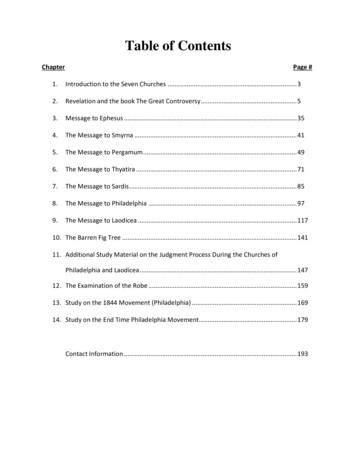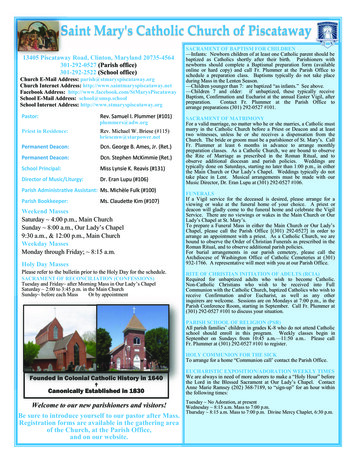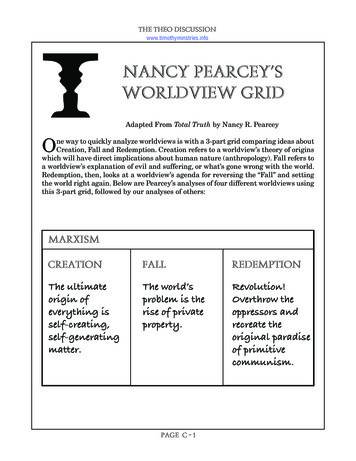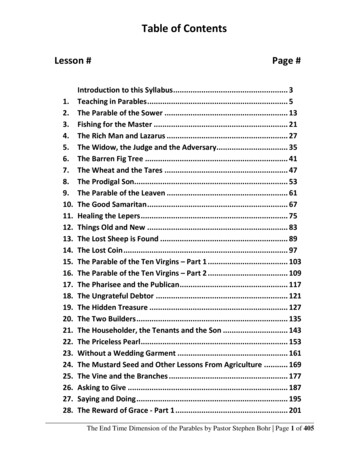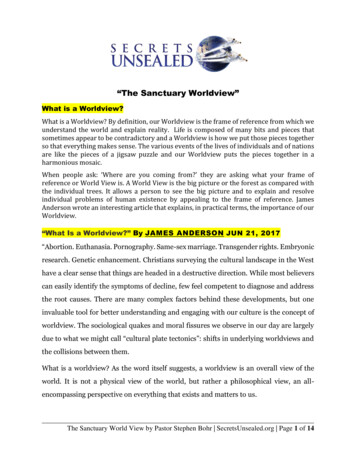
Transcription
“The Sanctuary Worldview”What is a Worldview?What is a Worldview? By definition, our Worldview is the frame of reference from which weunderstand the world and explain reality. Life is composed of many bits and pieces thatsometimes appear to be contradictory and a Worldview is how we put those pieces togetherso that everything makes sense. The various events of the lives of individuals and of nationsare like the pieces of a jigsaw puzzle and our Worldview puts the pieces together in aharmonious mosaic.When people ask: ‘Where are you coming from?’ they are asking what your frame ofreference or World View is. A World View is the big picture or the forest as compared withthe individual trees. It allows a person to see the big picture and to explain and resolveindividual problems of human existence by appealing to the frame of reference. JamesAnderson wrote an interesting article that explains, in practical terms, the importance of ourWorldview.“What Is a Worldview?” By JAMES ANDERSON JUN 21, 2017“Abortion. Euthanasia. Pornography. Same-sex marriage. Transgender rights. Embryonicresearch. Genetic enhancement. Christians surveying the cultural landscape in the Westhave a clear sense that things are headed in a destructive direction. While most believerscan easily identify the symptoms of decline, few feel competent to diagnose and addressthe root causes. There are many complex factors behind these developments, but oneinvaluable tool for better understanding and engaging with our culture is the concept ofworldview. The sociological quakes and moral fissures we observe in our day are largelydue to what we might call “cultural plate tectonics”: shifts in underlying worldviews andthe collisions between them.What is a worldview? As the word itself suggests, a worldview is an overall view of theworld. It is not a physical view of the world, but rather a philosophical view, an allencompassing perspective on everything that exists and matters to us.The Sanctuary World View by Pastor Stephen Bohr SecretsUnsealed.org Page 1 of 14
A person’s worldview represents his most fundamental beliefs and assumptions about theuniverse he inhabits. It reflects how he would answer all the “big questions” of humanexistence: fundamental questions about who and what we are, where we came from, whywe’re here, where (if anywhere) we’re headed, the meaning and purpose of life, the natureof the afterlife, and what counts as a good life here and now. Few people think throughthese issues in any depth, and fewer still have firm answers to such questions, but aperson’s worldview will at least incline him toward certain kinds of answers and awayfrom others.Worldviews shape and inform our experiences of the world around us. Like spectacleswith colored lenses, they affect what we see and how we see it. Depending on the “color”of the lenses, some things may be seen more easily, or conversely, they may be deemphasized or distorted—indeed, some things may not be seen at all.Worldviews also largely determine people’s opinions on matters of ethics and politics.What a person thinks about abortion, euthanasia, same-sex relationships, environmentalethics, economic policy, public education, and so on will depend on his underlyingworldview more than anything else.As such, worldviews play a central and defining role in our lives. They shape what webelieve and what we are willing to believe, how we interpret our experiences, how webehave in response to those experiences, and how we relate to others. Our thoughts andour actions are conditioned by our worldviews.The challenge is greater than ever. But we shouldn’t be discouraged, because theopportunities and resources available to us are also greater now than they have ever been.In the last half-century or so, there has been a remarkable renaissance in Christianphilosophy and apologetics, much of which has focused on developing and defending abiblical worldview. Whatever God calls His people to do, He equips them to do (see Eph.4:11-12; Heb. 13:20-21). The problem is not that the church is under-equipped, but thatshe has yet to make full use of what Christ has provided for her.The Sanctuary World View by Pastor Stephen Bohr SecretsUnsealed.org Page 2 of 14
Two foundational premises of the Seventh-day Adventist WorldviewThe Seventh-day Adventist Worldview is based upon a literal reading of Scripture andincludes two fundamental premises.First, the sin problem is universal in scope because it originated in heaven when Luciferrebelled against God. Therefore, the solution to the problem must be universal in scope aswell. Lucifer was able to deceive one third (“nearly half”; The Truth about Angels, p. 43) ofthe angels so his arguments against God’s character must have been deceptively persuasive.Satan smeared the character of God before the heavenly beings who bought the idea that Godwas an autocratic and dictatorial despot who cared only about His own self-interests andcraved the slavery of His servants. He claimed that God’s law restricts freedom and that itwas his intention to establish a government where everyone would be free. This made itnecessary for God to clear up all doubts about His character in order to bring unity andharmony back to the heavenly universe. The plan of salvation has the purpose of clearing upall doubts about God’s character and government.Second, God created a perfect world in seven literal days. Adam and Eve were literal, perfectpersons in a literal Garden. God created them with freedom of choice, Satan tempted themto sin, and they passed on the infection to all their descendants. The human race could notdig themselves out of the quicksand on their own and therefore they needed a redeemer.God’s redemptive solution to the universal problem of sin consists of seven steps. When wesee these seven steps as a whole, we have the key that allows us to explain the variousphenomena and events that surround us. These seven steps find their center in the sanctuaryservice:“The correct understanding of the ministration in the heavenly sanctuary is the foundation ofour faith.” Letter 208, 1906,Once Jesus completes the seven steps, the universe will be once again in absolute harmonyas it was before the inception of sin. Thus, for Adventists, the sanctuary is not a mere doctrineof the church it is the Worldview that links all the doctrines in a harmonious whole.If I was to ask which of the seven steps of Jesus is the most important the majority ofChristians would probably answer, the cross! No doubt, the cross is central, but each step isactually just as important as the other is.The Seven StepsHere are the sevens steps that Jesus takes through the sanctuary to solve the universal sinproblem: Step #1: The sanctuary Camp: By His perfect life of obedience to the law in our midst,Jesus wove a robe of perfect righteousness that is available to every person who hasever lived. Every act of obedience was a thread that He added to the robe.Step #2: The Altar of Sacrifice: After living His holy life, the Father laid the sins of thewhole world upon Him and He felt the pangs of second death that sinners deserve.Step #3: The Laver: Jesus resurrected from the dead in order to fulfill His nextfunction—the application of the benefits of His atonement to individual sinnersThe Sanctuary World View by Pastor Stephen Bohr SecretsUnsealed.org Page 3 of 14
Step #4: The Holy Place: Jesus intercedes for individuals who come to Him inrepentance, confession and faith. That is to say, He applies the benefits of theatonement to individuals who personally claim them. Jesus forgives the sins of thepenitent and places them in the sanctuary through His blood.Step #5: The Most Holy Place: In the investigative pre-advent judgment, Jesusexamines the cases of all who professed His name to reveal to the heavenly universeif they are entitled to the benefits that the atonement provided. The purpose of thejudgment is to reveal if repentance was genuine and a changed life is the evidence oftrue repentance. During the intercessory ministry of Jesus, the sins of the trulypenitent are temporarily imputed to the sanctuary until Jesus can roll them over uponthe one who is truly responsible for the inception and existence of sin.Step #6: The outer Court: Jesus takes the sins of the truly penitent and disposes ofthem, placing them upon the being who is ultimately responsible for the origin andexistence of sin—Satan. Thus in the daily service the sin moves from the sinner toJesus to the sanctuary and on the Day of Atonement it moves from the sanctuary toJesus to Satan. Satan—the scapegoat—is then exiled for a thousand years after whichhe is destroyed along with his angels and the impenitent.Step #7: The Camp: After the eradication of sin and sinners from the universe, Jesuswill abide with His people, in their camp, for evermore.Step Number One: The Work of Jesus in the CampJesus takes human flesh in order to weave a robe of perfect righteousness that He can offerto everyone who comes to God through Him.Biblical Evidence:Matthew 1:23:"Behold, the virgin shall be with child, and bear a Son, and they shall call His name Immanuel,"which is translated, "God with us."Exodus 25:8:“And let them make Me a sanctuary, that I may dwell among them.”John 1:14: Jesus came to ‘tabernacle’ with us in the sanctuary camp:“And the Word became flesh and dwelt [same word for ‘tabernacle’] among us, and we beheldHis glory, the glory as of the only begotten of the Father, full of grace and truth.”Physical and spiritual nakedness was the first consequence of sin (Genesis 3:8) andtherefore the problem of human nakedness must be resolved first. We cannot offer the lawa perfect robe of righteousness because ‘all have sinned and come short of the glory of God’,and ‘there is none righteous, no, not one’ (Romans 3:23, 10). For this reason, Jesus came toweave a robe of perfect righteousness that He could offer the law to cover the shame of man’snakedness. Each act of obedience during His life on earth was a thread that He added to therobe, and when He said on the cross, ‘it is finished’, the weaving of the robe was complete.The robe was then available for every single person who has ever drawn breath!The Sanctuary World View by Pastor Stephen Bohr SecretsUnsealed.org Page 4 of 14
Biblical evidence:In the Old Testament sacrificial system, the slain victim as well as the officiating priest hadto be without blemish:Leviticus 22:20-22: The sacrificial victim could have no blemish:“Whatever has a defect, you shall not offer, for it shall not be acceptable on your behalf. 21 Andwhoever offers a sacrifice of a peace offering to the Lord, to fulfill his vow, or a freewill offeringfrom the cattle or the sheep, it must be perfect to be accepted; there shall be no defect in it. 22Those that are blind or broken or maimed, or have an ulcer or eczema or scabs, you shall notoffer to the Lord, nor make an offering by fire of them on the altar to the Lord.”Leviticus 21:17-21: The officiating priest could have no blemish as well:"Speak to Aaron, saying: 'No man of your descendants in succeeding generations, who has anydefect, may approach to offer the bread of his God. 18 For any man who has a defect shall notapproach: a man blind or lame, who has a marred face or any limb too long, 19 a man who hasa broken foot or broken hand, 20 or is a hunchback or a dwarf, or a man who has a defect in hiseye, or eczema or scab, or is a eunuch. 21 No man of the descendants of Aaron the priest, whohas a defect, shall come near to offer the offerings made by fire to the Lord. He has a defect; heshall not come near to offer the bread of his God.”Exodus 12:5: The Passover lamb could have no blemish:“Your lamb shall be without blemish, a male of the first year. You may take it from the sheepor from the goats.”Note: The lack of a physical blemish on the victim and priest in the Old Testament systemrepresented the fact that Jesus had no moral blemish. Sometimes we focus so much on thedeath of Jesus on the cross that we forget that His perfect life was just as necessary as Hisdeath. If Jesus had not lived a perfect life of righteousness, the Father would not haveaccepted His sacrifice.1 Peter 1:18-20: Jesus is the unblemished lamb:“. . . knowing that you were not redeemed with corruptible things, like silver or gold, from youraimless conduct received by tradition from your fathers, 19 but with the precious blood of Christ,as of a lamb without blemish and without spot. 20 He indeed was foreordained before thefoundation of the world, but was manifest in these last times for you. . .”Hebrews 4:15: Jesus is also the unblemished Priest who offered Himself:“Seeing then that we have a great High Priest who has passed through the heavens, Jesus theSon of God, let us hold fast our confession. 15 For we do not have a High Priest who cannotsympathize with our weaknesses, but was in all points tempted as we are, yet without sin.16 Let us therefore come boldly to the throne of grace that we may obtain mercy and find graceto help in time of need.”Hebrews 7:25: Jesus can serve as our high priest because He lived a holy and blamelesslife:“For such a High Priest was fitting for us, who is holy, harmless, undefiled, separate fromsinners, and has become higher than the heavens.”The Sanctuary World View by Pastor Stephen Bohr SecretsUnsealed.org Page 5 of 14
John 19:6: Even the pagan ruler, Pontius Pilate, found no fault in Jesus:“Therefore, when the chief priests and officers saw Him, they cried out, saying, "Crucify Him,crucify Him!" Pilate said to them, "You take Him and crucify Him, for I find no fault in Him."Note: The work of Jesus in the camp was objective. That is, the robe of righteousness thathe wove is available to every human being who has ever lived. Jesus lived in place of all!Step Number 2: The Work of Jesus in the Court: The Altar of SacrificeIt was not sufficient for Jesus to weave a robe of perfect righteousness. Sin is thetransgression of the law (1 John 3:4) and the wages of sin is death (Romans 6:23). Afterliving a life of perfect righteousness, the Father laid on Him the sins of all and He sufferedtheir penalty. In Gethsemane and on the cross, every sin that has ever been committedpressed upon His soul. On the cross He bore the nakedness that we deserve (John 19:23, 24).The events at Gethsemane and the cross reveal that sin is a terrible monster. In order toovercome sin, we must see what it did to Jesus, our friend!Biblical Evidence:John 3:16: The Father gave Jesus to die for the sins of the whole world:“For God so loved the world, that He gave His Only Begotten Son. . .”2 Corinthians 5:21: Jesus knew no sin (his perfect life) but then was made sin so that wecould be found righteous in Him:“For He made Him who knew no sin to be sin for us, that we might become the righteousnessof God in Him.”Galatians 3:13: Jesus took upon Himself the curse that belonged to all humanity:“Christ has redeemed us from the curse of the law, having become a curse for us (for it iswritten, "Cursed is everyone who hangs on a tree").”Hebrews 2:9: Jesus tasted death for everyone:“But, we see Jesus, who was made a little lower than the angels, for the suffering of deathcrowned with glory and honor, that He, by the grace of God, might taste death for everyone.”1 John 2:1, 2: Jesus not only propitiated the sins of the saved but also the sins of the wholeworld:“My little children, these things I write to you, so that you may not sin and if anyone sins, wehave an Advocate with the Father, Jesus Christ the righteous. 2And He Himself is the propitiationfor our sins, and not for ours only but also for the whole world.”Isaiah 53:5, 6: The sacrifice of Jesus was vicarious:“But He was wounded for our transgressions, He was bruised for our iniquities; thechastisement for our peace was upon Him, and by His stripes we are healed. 6 All we like sheephave gone astray; we have turned, every one, to his own way; and the Lord has laid on Him theiniquity of us all.”The Sanctuary World View by Pastor Stephen Bohr SecretsUnsealed.org Page 6 of 14
Ellen White concurs with the testimony of Scripture:Selected Messages, volume 1, p. 321:“The guilt of every sin pressed its weight upon the divine soul of the world's Redeemer. The evilthoughts, the evil words, the evil deeds of every son and daughter of Adam, called forretribution upon Himself; for He had become man's substitute. Though the guilt of sin was notHis, His spirit was torn and bruised by the transgressions of men, and He who knew no sinbecame sin for us, that we might be made the righteousness of God in Him.”Note: The life of Jesus in the camp and His death in the court was for every single humanbeing who has ever lived. His perfect life of righteousness and His death for sin are thebenefits of the atonement or gift that He purchased for each human being. However, as weshall soon see, the individual sinner must personally claim and receive the gift in order toenjoy the benefits that Jesus purchased.Step Number 3: The Work of Jesus in the Court: The LaverThe laver was located after the altar of sacrifice and before the holy place of the sanctuary.This must mean that the laver represents an event that took place between the death ofJesus on the cross and the beginning of His high priestly ministry in the holy place upon Hisascension.After the Old Testament priest offered the sacrifice, his garments had the stain of death anddeath defiles. Therefore, before the priest could apply the blood of the sacrifice in the holyplace, he needed to wash himself of every vestige of the defilement of death. A person whogoes into the baptismal waters comes forth, and his sins are washed away and he resurrectsto newness of life (see Acts 22:16).Paul’s letter to Titus places washing and regeneration in parallel fashion.Biblical Evidence:Titus 3:4, 5: The laver of regeneration represents the resurrection of Jesus in the court:“But when the kindness and the love of God our Savior toward man appeared, 5 not by works ofrighteousness which we have done, but according to His mercy He saved us, through thewashing of regeneration and renewing of the Holy Spirit.”Note: According to Kittel’s Theological Dictionary of the New Testament:“This word derives from palin [again] and guenesis [begin] and thus means ‘new genesis’ eitherin the sense of a. ‘return to existence,’ ‘coming back from death to life,’ or of b. ‘renewal to ahigher existence,’ ‘regeneration’ in the usual sense.”In the Old Testament system the priest had to cleanse himself from every vestige of deathbefore He could move on to the next phase of his work—intercession. Likewise, when Jesusresurrected, He ‘cleansed’ Himself from the stain of death once-and-for-all and therefore isable to intercede for us. Notice that this text underlines that Jesus resurrected from the dead(the laver) and therefore is able to intercede for us (in the holy place):The Sanctuary World View by Pastor Stephen Bohr SecretsUnsealed.org Page 7 of 14
Romans 6:9, 10:“. . . knowing that Christ, having been raised from the dead, dies no more. Death no longerhas dominion over Him. 10 For the death that He died, He died to sin once for all; but the lifethat He lives, He lives to God.”Romans 4:25: Most Christians assume that the death of Jesus justified sinners but in reality,His death provided the means whereby Jesus could justify them. Justification or forgivenessof sins is possible because Jesus resurrected from the dead:“Now it [the story of Abraham’s justification when he believed God] was not written for hissake alone that it was imputed to him, 24 but also for us. It shall be imputed to us who believein Him who raised up Jesus our Lord from the dead, 25 who was delivered up because of ouroffenses, and was raised for our justification.”1 Corinthians 15:3-7, 17-19: Many Christians assume that the death of Jesus forgave thesins of individuals, however, without the resurrection, there could be no forgiveness forsin:“For I delivered to you first of all that which I also received: that Christ died for our sinsaccording to the Scriptures, 4 and that He was buried, and that He rose again the third dayaccording to the Scriptures, 5 and that He was seen by Cephas, then by the twelve. 6 After thatHe was seen by over five hundred brethren at once, of whom the greater part remain to thepresent, but some have fallen asleep and after that He was seen by James, then by all theapostles. 8 Then last of all He was seen by me also, as by one born out of due time. 17 And if Christis not risen, your faith is futile; you are still in your sins! 18 Then also, those who have fallenasleep in Christ have perished. 19 If in this life only we have hope in Christ, we are of all menthe most pitiable. “Summary of the work in the camp and the court of the sanctuary:The work of Jesus in the camp and in the court are the objective benefits of his atonementand are accessible to all those who claim them individually. By His life and death, Jesusfinished the atonement in terms of provision but not in terms of individual application.Step Number 4: The Work of Jesus in the Holy PlaceJohn 3:16 (second half of the verse). We previously noted that Jesus lived and died for everyperson who has ever lived. Does this mean that everyone on earth will finally be saved? Ofcourse not! The benefits of salvation are available to every human being but individuals mustclaim those benefits.“And as Moses lifted up the serpent in the wilderness, even so must the Son of Man be lifted up,15 that whoever believes in Him should not perish but have eternal life. For God so loved theworld that He gave His only begotten Son that whosoever believes in Him should not perishbut have everlasting life.”Jesus, by His life and death, purchased the gift of salvation for every person who has everdrawn breath (Romans 6:23). The giver pays for a gift but to the receiver it is free. However,the receiver has the option of accepting or rejecting the gift.The Sanctuary World View by Pastor Stephen Bohr SecretsUnsealed.org Page 8 of 14
Bank Illustration:The owner of a bank out of kindness and mercy decides to set up a special account withsufficient capital to pay all the debts of every person who has ever lived. There is enoughcapital in the bank to wipe out all debt, mortgage loans, credit cards, department stores,educational bills, auto loans—you name it!However, what good would it do to have the capital in the bank if no one knew that it wasavailable? Therefore, the owner of the bank announces to everyone on the planet that hehas deposited enough capital in the bank to pay for all of their debts. Through word of mouth,the internet, Facebook, What’s Up, Twitter, television, radio and the press he announces thegood news!However, there is a catch: the condition for debt cancellation is that individuals mustpersonally come to the bank owner, repenting of incurring debt, confessing that they didwrong to incur it and trusting that the bank owner is serious about paying their debt. Thecapital is available for everyone but whoever does not come to the bank will remain in debt!Ellen White hinted at the bank illustration in the following quotation:“Christ has pledged Himself to be our substitute and surety, and He neglects no one. There is aninexhaustible fund of perfect obedience accruing from His obedience. In heaven, His merits,His self-denial and self-sacrifice, are treasured up as incense to be offered up with the prayersof His people. As the sinner's sincere, humble prayers ascend to the throne of God, Christmingles with them the merits of His life of perfect obedience. Our prayers are made fragrantby this incense.” Australasian Union Conference Record, June 1, 1900.I cannot repeat enough that the work that Jesus did in the camp and in the court iscorporate but the work that He does in the heavenly sanctuary is individual and personal.What has Jesus been doing in heaven for the last two thousand years? The answer is thatHe has been crediting His life and death to the account of those who come to Him inrepentance and faith thus taking the capital in the bank and cancelling their personal debt.After Jesus lived, died and resurrected on earth, he went to the holy place to apply torepentant individuals the benefits of His earthly work.Biblical Evidence:1 John 2:1, 2: Our advocate has perfect righteousness that He can impute to repentantsinners:“My little children, these things I write to you, so that you may not sin. And if anyone sins, wehave an Advocate with the Father, Jesus Christ the righteous.”Hebrews 7:25: Jesus intercedes only for those who come to God through Him:“Therefore He is also able to save to the uttermost those who come to God through Him, sinceHe always lives to make intercession for them.”Romans 8:31-34: Jesus intercedes only for the elect:“Who shall bring a charge against God's elect? God justifies. 34 Who is he who condemns? It isChrist who died, and furthermore is also risen, who is even at the right hand of God, who alsomakes intercession for us.”The Sanctuary World View by Pastor Stephen Bohr SecretsUnsealed.org Page 9 of 14
The Bible does not teach that Jesus forgave all sins at the cross:Acts 2:38: The sins of individuals are forgiven when they repent and are baptized:“Then Peter said to them: "Repent, and let every one of you be baptized in the name of JesusChrist for the remission of sins; and you shall receive the gift of the Holy Spirit.”Acts 5:31: Jesus went to heaven to give repentance to Israel:“Him God has exalted to His right hand to be Prince and Savior, to give repentance to Israeland forgiveness of sins.”Acts 10:43; John 3:14-16: When individuals believe in Jesus, God forgives their sins:“To Him all the prophets witness that, through His name, whoever believes in Him will receiveremission of sins."“And as Moses lifted up the serpent in the wilderness, even so must the Son of Man be lifted up,15 that whoever believes in Him should not perish but have eternal life. 16 For God so lovedthe world that He gave His only begotten Son, that whoever believes in Him should not perishbut have everlasting life.”1 John 1: 9: The sins of individuals are forgiven when they confess them and they confessthem because they are sorry they committed them:“If we confess our sins, He is faithful and just to forgive us our sins and to cleanse us fromall unrighteousness.”Proverbs 28:13: Mercy comes when individuals confess and forsake sin:“He who covers his sins will not prosper but whoever confesses and forsakes them will havemercy.”Ellen White concurs with Scripture:Christ’s Object Lessons, p. 311:“Only the covering which Christ Himself has provided can make us meet to appear in God'spresence. This covering, the robe of His own righteousness, Christ will put upon everyrepenting, believing soul.”The Faith I Live By, p. 107:“The grace of Christ is freely to justify the sinner without merit or claim on his part.Justification is a full, complete pardon of sin. The moment a sinner accepts Christ by faith,that moment he is pardoned. The righteousness of Christ is imputed to him, and he is no moreto doubt God's forgiving grace.”The story of the prodigal son helps us understand the steps in the process of justification: The selfish son left home, unhappy with the rules of the householdFor a season, he enjoyed the pleasures of sinWhen disaster finally struck, he realized the folly of his choices and repentedWhen he hit rock bottom the goodness of his father drew him toward home (seeRomans 2:4)His repentance led him to prepare a confession speechThe Sanctuary World View by Pastor Stephen Bohr SecretsUnsealed.org Page 10 of 14
He confessed to his father that he was not worthy to be his sonThe father placed upon him His choice robe, forgiving him and reinstating him assonNot all repentance and confession are genuine and sincere. During the holy placeintercessory ministry of Jesus, the sincerity of repentance is not tested. When a personclaims to repent and confesses his sin, Jesus takes that person at his word and pours outthe benefits of his atonement. However, in the judgment, the person’s works will reveal ifthey were sincere and are really entitled to the benefits.Ellen White explained the relationship between receiving the benefits of the atonementand being entitled to the benefits:The Story of Redemption, p. 386:“The rending of the veil of the temple showed that the Jewish sacrifices and ordinances wouldno longer be received. The great Sacrifice had been offered and had been accepted, and theHoly Spirit which descended on the day of Pentecost carried the minds of the disciples from theearthly sanctuary to the heavenly, where Jesus had entered by His own blood, to shed upon Hisdisciples [not the whole world] the benefits of His atonement.”The judgment will reveal whether the person was entitled to the benefits:“As the sins of the people were anciently transferred, in figure, to the earthly sanctuary by theblood of the sin offering, so our sins are, in fact, transferred to the heavenly sanctuary by theblood of Christ. Moreover, as the typical cleansing of the earthly was accomplished by theremoval of the sins by which it had been polluted, so the actual cleansing of the heavenly is tobe accomplished by the removal, or blotting out, of the sins that are there recorded. Thisnecessitates an examination of the books of record to determine who, through repentance ofsin and faith in Christ, are entitled to the benefits of His atonement.” The Faith I Live By, p.206Since the late forties and early fifties there has been a debate among Adventist scholarswhether Jesus finished the atonement on the cross. Desmond Ford affirmed that theatonement was finished at the cross and therefore the Day of Atonement occurred at thecross and not in 1844. However, there is no need for a debate on this question. The simpl
the root causes. There are many complex factors behind these developments, but one invaluable tool for better understanding and engaging with our culture is the concept of worldview. The sociological qu
